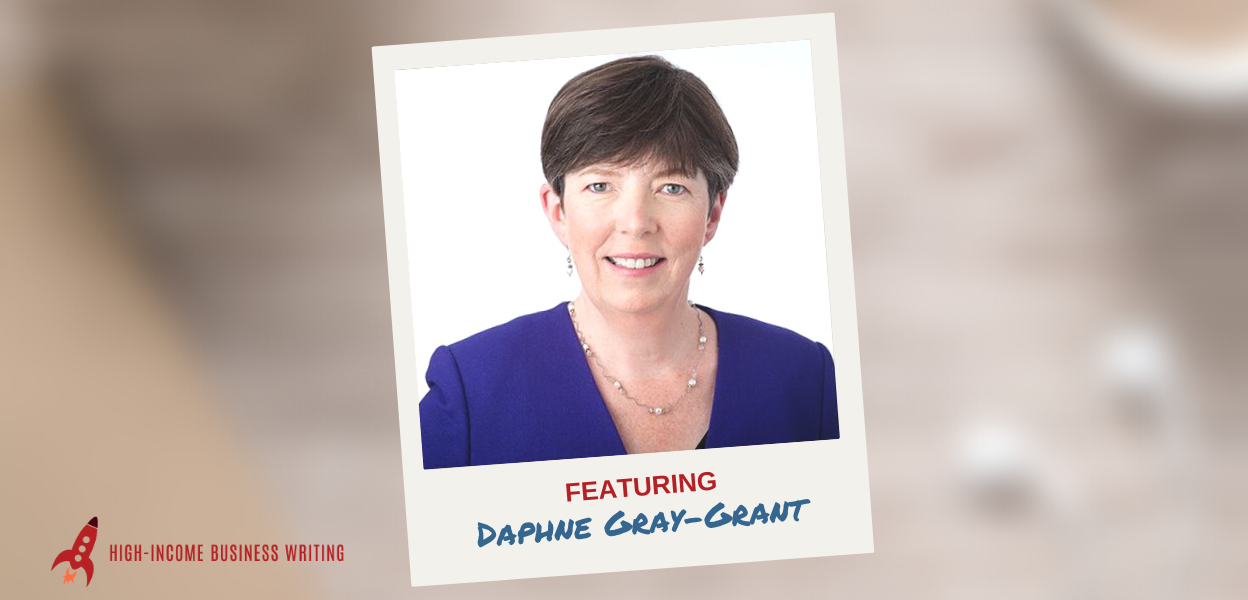You landed the project for a great fee. That’s the good news.
The bad news is that now you have to crank out a first draft. And after hours (or days!) of staring at a blank screen, you’re getting anxious.
That anxiety leads to stress. And the stress starts to unleash that inner critic.
The good news is, this doesn’t have to be the reality for every writing project — especially if you have a proven process and set of hacks for writing your first draft faster.
That’s the topic of today’s episode. My guest is writing coach Daphne Gray-Grant, author of the newly published book Your Happy First Draft: A Practical and Painless Guide to Obliterating Writer’s Block.
Daphne was one of my first podcast guests back in 2013. Her episode is one of my most popular episodes ever! She was so great that I wanted to bring her back to share some insights and tips for writing first drafts faster.
In this conversation, she explains why you need a crummy first draft, how to use mind mapping for inspiration and practical tips to stop editing as you write.
And how to be realistic and kind to yourself during the entire process.
The notes that follow are a very basic, unedited summary of the show. There’s a lot more detail in the audio version. You can listen to the show using the audio player below. Or you can subscribe in iTunes to get this show delivered straight to the Podcasts app on your smart phone, tablet or iPod.


High-Income Business Writing with Ed Gandia
#197:Daphne Gray-Grant on How to Obliterate Writer’s Block and Get Your First Draft DONE
Tell us about yourself
Even in high school, Daphne loved editing. When she entered the work force she first worked as an editor at her family’s newspaper and then later at a larger metropolitan newspaper.
After starting a family, she decided to start consulting. That consulting brought her some writing work, and she quickly discovered she hated it!
It took her a long time to write anything, so she did some research to find out what she was doing wrong.
Eventually, she learned how to write quickly, easily and better. Other people started to ask her for help with the same problem.
Today, she has clients all over the world. They tend to fall into one of three groups: academics, business owners or fiction writers.
When you charge flat fees for projects, every additional hour you’re spending brings down your internal hourly rate. This creates anxiety that can dampen your creativity.
When you charge a flat fee for projects, writing slowly will bring down your internal hourly rate.
Many writers resist the idea of creating a crummy first draft — even if they’re the only ones who will see it. Why do you think that is?
Writers are often big readers. And we sometimes start to think that published books came out of the writers’ brain in that perfect form. When we can’t do the same thing ourselves, we question our own competence.
But even Hemingway didn’t write perfect first drafts!
Writing a crappy first draft is a way to get the words out of your head and onto the page. Once they’re on the page, you have something you can edit!
Western society tends to reward linear logical tasks. Editing is linear. But writing is a creative, non-linear task. Most of us aren’t accustomed to doing creative work. So we’re much more comfortable editing — and being critical — than we are writing.
We need to turn off that critical voice when we’re writing and be mindful that different tasks are associated with “writing.” Writing is one task. Editing is a different task. You need to perform both at separate times.
How can we compartmentalize these two tasks?
One option is to turn off your screen when you’re writing. If you can’t see what you’re writing, you can’t edit it.
A similar hack is to make your font size so small you can’t read it.
This might sound extreme. But you quickly get used to it. And writing becomes more fun.
What other ways can we get the editor out of our heads?
Writing with voice activation software is another approach you can try.
Mind mapping is another great technique for capturing your thoughts and getting them on paper. Daphne has links on her website to her videos and blog posts on mind mapping.
Here’s where things tend to go wrong when you mind map:
- A mind map is not the same as an outline. Mind maps aren’t an organizational tool, they’re an inspirational tool. You should mind map until you feel inspired to write. Daphne calls it the “aha” experience.
- Start with a question, not a topic. Some people suggest you should write your topic in the center of your mind map. But Daphne has learned that writers do better if they put a question in the center of the page.
A question is provocative. It provides direction and focus. And you’re more likely to come up with things to write. It’s more likely to spark the creative brain.
If you don’t feel inspired with your first mind map, you need to do a second mind map and ask a different question. If that second map doesn’t work, you need to do a third, etc.
Each mind map should only take three to five minutes to do. Even if you do six mind maps, that’s only 30 minutes. And people can spend a lot longer than that staring at a blank page.
You’re a fan of paper and pen when it comes to mind mapping. How come?
There’s lots of evidence that when we want to use our creative brains, we’re better off using paper and pen. Keyboards are better when you’re at the point of writing and want to get words down.
What other tips would you suggest to improve writing speed?
Being realistic about what you can achieve. Accomplishing any long form writing project is a long term project. You’re not going to write a typical book in a day, week or month. So you need to write a little bit each day.
We all have days where we’re too busy with work or other commitments to write. When such a day coming up in your calendar, give yourself permission to not write! It’s much better to do that than feel guilty about it.
When you’re not realistic with your goals, you can get discouraged. And it’s discouragement that does most people in.
How can writers better manage their emotions with this kind of work so they can stay on track?
Understand that you have your job (finish your writing) and your emotions have their job (to react). They may work at cross-purposes. And that’s okay.
Don’t ignore your emotions. Acknowledge them, but recognize that they’re just doing their thing.
Tell us about your new book
Daphne’s new book is Your Happy First Draft.
It goes through all the processes that will help you become a more comfortable writer, including mind mapping, dealing with emotions and breaking the habit of editing while writing.
Where can people learn more about you?
You can purchase Daphne’s book on her website:
https://www.publicationcoach.com
You can also sign up for her weekly newsletter there.
Daphne’s earlier podcast interview
https://b2blauncher.com/episode12/
Plus … whenever you’re ready, here are 4 ways I can help you grow your freelance business:
1. Grab a free copy of my book for ESTABLISHED writers/copywriters.
You’ll discover how to quickly and predictably reawaken dead leads, generate new client opportunities and convert not-yet-ready prospects into freelance writing clients. — Click Here
2. Download a free copy of my new book for writers who are NEW to freelancing.
I’ll show you the 3 things you need to do to get your business off the ground safely and land your first paying client faster. — Click Here
3. Join my implementation program and be a case study.
I’m putting together a new implementation group this month. If you’d like to work with me to grow your income quickly with better clients (and become one of my new success stories). Just email me at ed@b2blauncher.com and put “Case Study” in the subject line.
4. Get a 1:1 strategy call with me.
Are you a 6-figure writer who’s trying to earn more in less time with less stress? Let’s jump on a quick call and brainstorm some ideas for getting you there. Just email me at ed@b2blauncher.com and put “Brainstorm” in the subject line.






